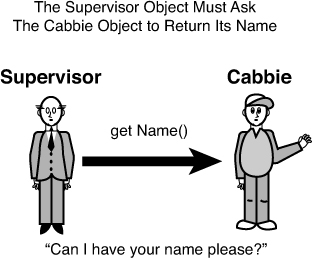Accessors
In most, if not all, examples in this book, the attributes are defined as private so that any other objects cannot access the attributes directly. It would be ridiculous to create an object in isolation that does not interact with other objects—for we want to share appropriate information. Isn’t it necessary to inspect and sometimes change another class’s attribute? The answer is, of course, yes. There are many times when an object needs to access another object’s attributes; however, it does not need to do it directly.
A class should be very protective of its attributes. For example, you do not want object A to have the capability to inspect or change the attributes of object B without object B having control. There are several reasons for this; the most important reasons boil down to data integrity and efficient debugging.
Assume that a bug exists in the Cab class. You have tracked the problem to the Name attribute. Somehow it is getting overwritten, and garbage is turning up in some name queries. If Name were public and any class could change it, you would have to go searching through all the possible code, trying to find places that reference and change Name. However, if you let only a Cabbie object change Name, you’d have to look only in the Cabbie class. This access is provided by a type of method called an accessor. Sometimes accessors are referred to as getters and setters, and sometimes they’re simply called get() and set(). By convention, in this book, we name the methods with the set and get prefixes, as in the following:
// Set the Name of the Cabbie
public void setName(String iName) {
name = iName;
}
// Get the Name of the Cabbie
public String getName() {
return name;
}
In this code snippet, a Supervisor object must ask the Cabbie object to return its name (see Figure 4.4). The important point here is that the Supervisor object can’t retrieve the information on its own; it must ask the Cabbie object for the information. This concept is important at many levels. For example, you might have a setAge() method that checks to see whether the age entered was 0 or below. If the age is less than 0, the setAge() method can refuse to set this incorrect value. In general, the setters are used to ensure a level of data integrity.
Figure 4.4. Asking for information.
This is also an issue of security. You may have sensitive data, such as passwords or payroll information that you want to control access to. Thus, accessing data via getters and setters provides the capability to use mechanisms like password checks and other validation techniques. This greatly increases the integrity of the data.
Notice that the getCompanyName method is declared as static, as a class method; class methods are described in more detail in Chapter 3. Remember that the attribute companyName is also declared as static. A method, like an attribute, can be declared static to indicate that there is only one copy of the method for the entire class.
The following code fragment illustrates how to define a static method, and Figure 4.5 shows how more than one object points to the same code.
Figure 4.5. Method memory allocation.
// Get the Name of the Cabbie
public static String getCompanyName() {
return companyName;
}


